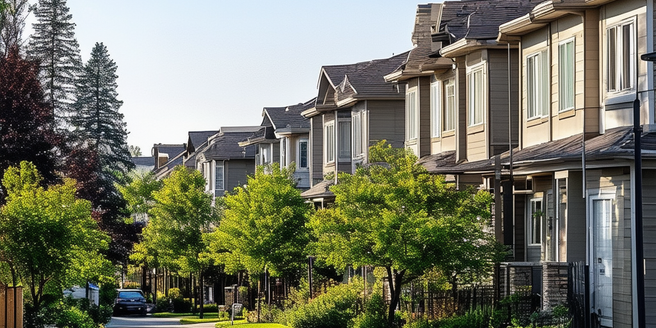Myth 1: Affordable Housing Lowers Property Values
One of the most pervasive myths about affordable housing is that it lowers property values. However, studies have shown that well-designed and well-maintained affordable housing can coexist with higher property values. Many people believe that the presence of affordable housing negatively impacts the surrounding area, but research consistently disproves this assumption. In fact, when affordable housing developments are well-integrated into a community, they can stimulate local economies and improve neighborhoods. This integration can lead to increased foot traffic for local businesses, higher consumer spending, and overall economic growth. The key is ensuring quality design, proper maintenance, and community integration. Additionally, well-executed affordable housing can enhance the aesthetic appeal of a neighborhood, contributing to an overall sense of pride and belonging among residents. By focusing on these essential aspects, affordable housing can become a valuable asset that enhances the vibrancy and resilience of communities.
Myth 2: Only Government-Funded Housing is Affordable
Another common misconception is that only government-subsidized housing can be affordable. In reality, a variety of affordable housing options exist, including nonprofit organizations, private developers, and community land trusts. These entities often work collaboratively to provide housing solutions that are affordable to a broader spectrum of the population, independent of direct government funding.
Nonprofit organizations play a crucial role in this ecosystem by leveraging donations, grants, and volunteer efforts to create and maintain affordable housing. They often focus on underserved populations, ensuring that even those with the lowest incomes can find a place to live. Private developers, on the other hand, may offer affordable units as part of larger, mixed-income developments. They can benefit from tax incentives or zoning allowances that make it financially viable to include affordable housing in their projects.
Community land trusts separate the ownership of the land from the housing built upon it, which helps to keep housing prices lower and more stable over time. This model allows for community control and long-term affordability, making it a sustainable option for many families. By combining these diverse strategies, the overall market for affordable housing becomes more resilient and inclusive.
Myth 3: Affordable Housing Attracts Crime
There is a prevailing belief that affordable housing attracts crime, but research consistently debunks this myth. Numerous studies and evidence show that crime rates are influenced by a range of factors, including economic conditions, community engagement, and local policing. Affordable housing developments that are well-designed and have strong community ties often see no increase in crime rates. These projects foster a sense of belonging and pride among residents, which can deter criminal activities.
Supported by various community programs and initiatives, these developments promote positive interactions among residents, creating a sense of community that reduces crime as people look out for each other and report suspicious activities. Affordable housing can also stimulate local economies by providing construction jobs, increasing the customer base for local businesses, and attracting further investments in the area. This economic uplift can play a role in reducing crime, as better economic conditions generally correlate with lower crime rates.
In conclusion, when designed thoughtfully and integrated into the community, affordable housing can help build stable and safe neighborhoods, highlighting the importance of dispelling unfounded fears with factual evidence and community success stories.
Myth 4: Affordable Housing is a Temporary Fix
Affordable housing is commonly thought to be only a temporary solution. However, it can offer long-term benefits by providing stable, cost-effective living conditions for low- and moderate-income families. Properly funded and maintained affordable housing can serve as a lasting solution to housing needs.
For instance, families residing in affordable housing are less likely to experience frequent relocations, which can disrupt children’s education and adults’ employment. With fewer financial worries, parents can focus more on their jobs and communities, resulting in increased productivity and enhanced quality of life. Additionally, stable housing conditions reduce stress and improve overall well-being, allowing families to thrive and reach their full potential.
Affordable housing developments often include amenities such as parks and community centers, which enrich residents’ lives and foster stronger community bonds. These neighborhoods can become vibrant hubs of social activity, where residents support each other, and local businesses flourish. By investing in affordable housing, we not only address immediate housing needs but also lay the groundwork for sustainable, long-term growth and stability in our communities.
In summary, affordable housing is not just a short-term fix; it is a viable, enduring solution that offers numerous benefits to individuals, families, and society as a whole.
Myth 5: Affordable Housing is Poor Quality
A widespread misconception is that affordable housing equates to poor quality. However, this notion is far from the truth. In reality, most affordable housing developments are subject to rigorous design and construction standards. These regulations help ensure that affordable housing is not only safe and functional, but also aesthetically pleasing and energy-efficient. Many people might be surprised to learn that stringent guidelines are in place to oversee the development of affordable housing projects. These guidelines ensure that the materials used are durable and the construction methods employed adhere to high standards of safety and performance.
Quality affordable housing provides dignity and stability for its residents. Beyond just providing a roof over one’s head, well-designed affordable housing can contribute significantly to the well-being of individuals and families. Residents experience a sense of pride and ownership when they live in homes that look good and function well. The positive impact extends to the broader community as well, fostering a sense of inclusivity and support. By debunking the myth that affordable housing equates to poor quality, we can recognize the considerable benefits such housing brings to society.



